The ASUS Zenbook UX305 Review
by Brett Howse on March 25, 2015 8:00 AM ESTDisplay
The UX305 comes with two display options. The base model is a 13.3 inch 1920x1080 IPS display, and no touch available. The display has a matte finish to it, which helps with glare. ASUS will also be offering a 3200x1800 Plane-to-Line Switching (PLS) model with a matte finish, and that model should be available in April or so. Optionally, both models can be equipped with touch.
The model that we received is the 1920x1080 version, and the display is from AU Optronics and is model AUO212D. At 166 pixels per inch, it is a good resolution for this size of display. It is a full RGB stripe, which is pretty typical for this resolution and size panel.
The anti-glare coating causes the sub-pixel distortion seen on this image. The AU display is a 6-bit model, but that is unsurprising given the low cost of this device. As an IPS display, it has great viewing angles and is a big step up over the TN panels that you may still find at this level of cost.
To test the display accuracy and its ability to reproduce color, we use SpectralCal’s CalMAN 5 software suite, with an X-Rite i1Display Pro colorimeter for brightness and contrast readings, and the X-Rite i1Pro spectrophotometer for color accuracy.
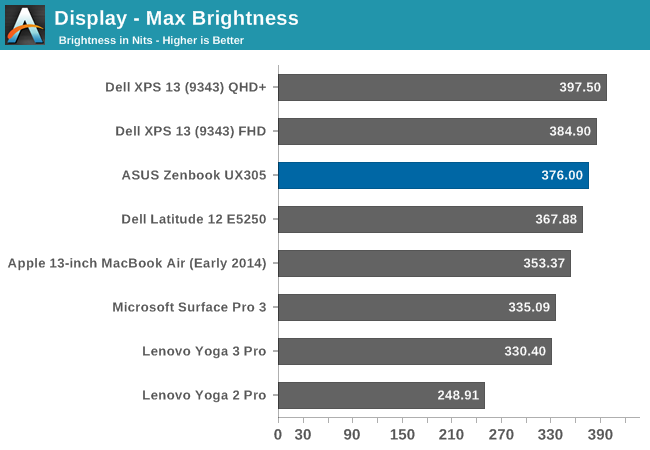
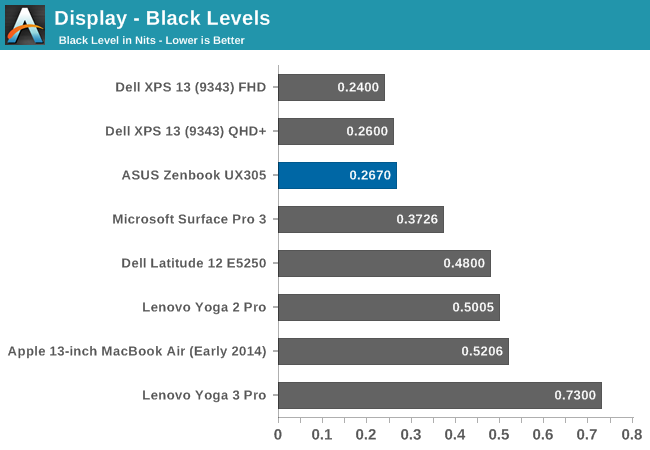
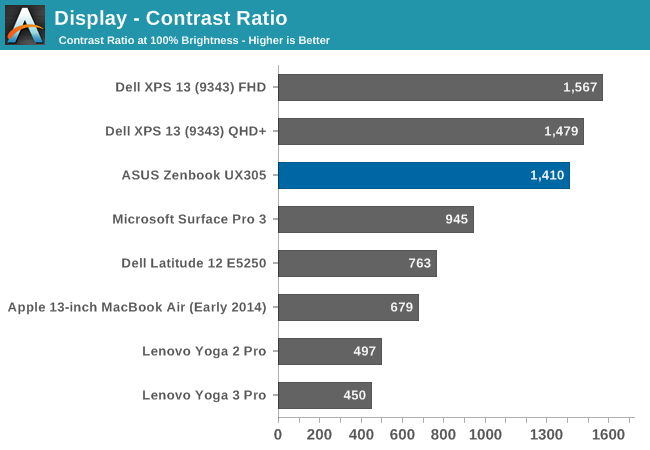
The maximum brightness for the UX305 is an impressive 376 nits. This combined with the anti-glare coating should make this a great laptop for any sort of bright room, or even outside. Even better, the panel has excellent black levels. ASUS rates the display for a contrast ratio of 500:1, but the model we received blew past that for a 1410:1 ratio which is fantastic.
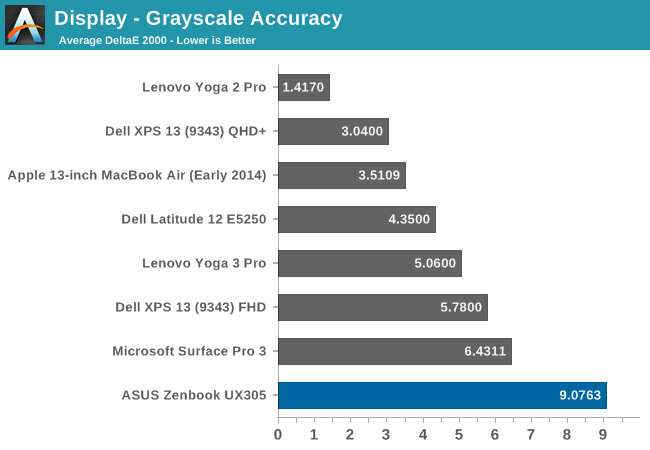
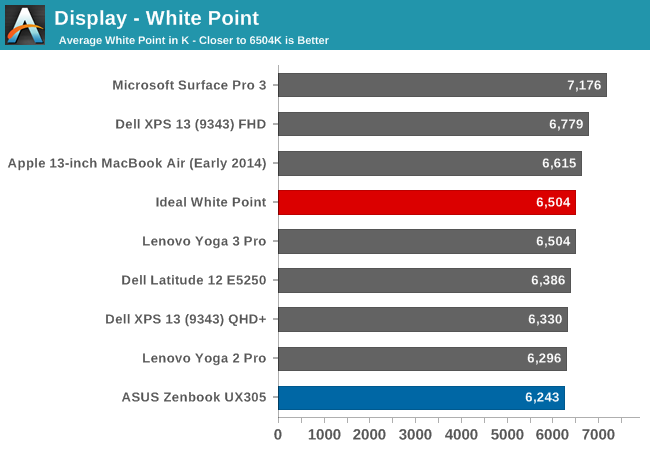
Unfortunately the great brightness and contrast is about where this display ends. The grayscale average is actually flattering the ASUS with a score of just over 9, because the error rate is between 12 and 13 from 70% brightness on. These are huge errors, since anything over 5 is a poor result, and really we are aiming for scores under three. The white point is off, and there is a huge green shift in the display by default.
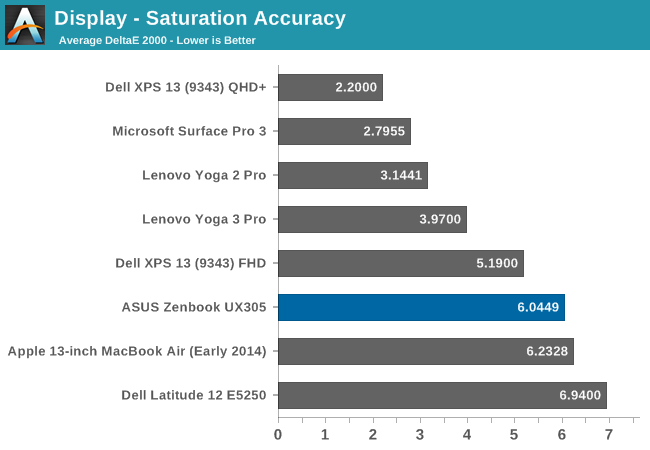
The saturation sweeps are not quite as bad as the grayscale, with the UX305 coming in just over 6. It is oversaturated on blue, undersaturated on red, and there is a green shift which pulls the yellows and teals off of their axis.
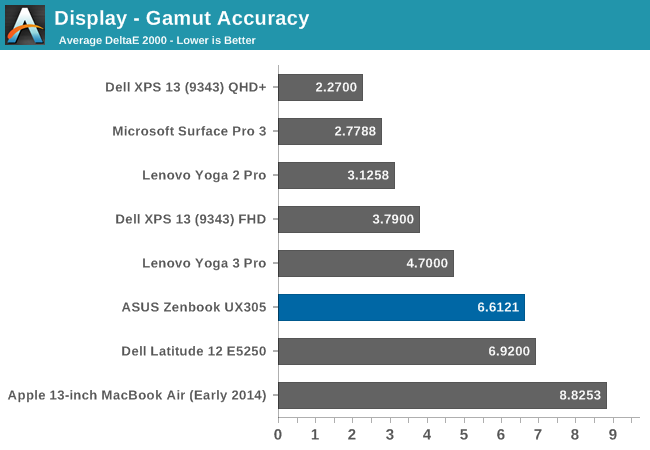
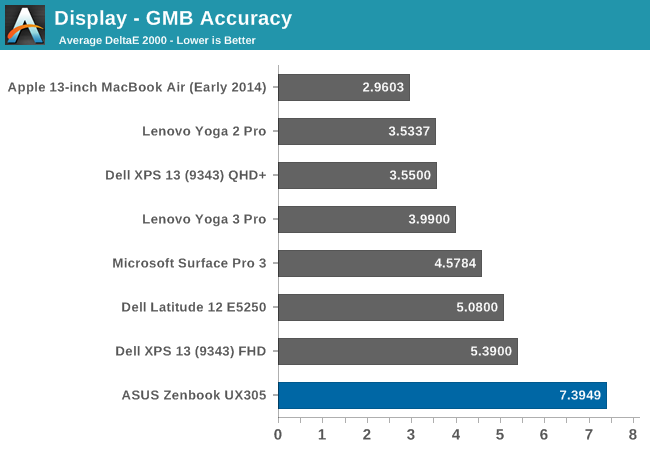
The GMB test is a more comprehensive test, and it scores very poorly again with a score over seven. The worst offenders were of course the white levels, which are very off, and the flesh tones on this display all had errors way over many of the other colors.
This is a very poor result and throws us back several years in terms of calibration. As far as out of the box performance goes the display can hit the entire sRGB colorspace, and as an IPS display it has great viewing angles, but otherwise there is nothing good to be said about this display as far as out of the box color accuracy goes.
To see if the display can be improved on with aftermarket calibration, I have run the display through our calibration software to try to fix some of the errors we encountered. Generally icc profiles will only really have a major effect on the grayscale, but that is the worst part of this display so hopefully we will be able to fix some of these issues.
Once calibrated, the display is almost completely different. There is still a large error on 100% white, but the overall grayscale drops to 0.9582, with a bit too much green but it is barely noticeable on most levels. The gamut drops to just 3.1256, saturation plummets to 1.9571, and the GMB test comes in at 2.3099.
If ASUS would take the time to include an icc profile for this display from the factory, it would be a lot better. It is amazing to me that ASUS would ship this display with it so far out of calibration, especially when calibrated it is almost perfect. Yes, the $699 price point is a factor, but the hard work was already done in getting a display that can produce these numbers. The easy part is taking the time to make it do that.


















164 Comments
View All Comments
thesavvymage - Wednesday, March 25, 2015 - link
im just an intern, but for my use case and everyone who works with me, this machine is NOT adequate for professional excel use. itd fall on its face trying to do pivots/charts with any substantial amount of rowsFlushedBubblyJock - Wednesday, March 25, 2015 - link
Watch, all these "premium feel", self centered, glory money show off, "elite items" freaks who want more than anything to feel rich inside when using their computer prods, will all have early onset alzheimer's, from picking and licking with their "super premium expensive feel" bragging egotist aluminum puters.I can hardly wait, though in that soon to engulf future condition they probably won't be able to understand why it happened to them.... just keeping rubbing those super elite aluminum bodies you constantly pine for...
kyuu - Wednesday, March 25, 2015 - link
While I actually prefer the design of, for example, the Yoga over aluminum designs like this or MacBooks, your spiel is rather psychopathic.FlushedBubblyJock - Wednesday, March 25, 2015 - link
Thanks for reading the vent, though don't say you weren't warned. Hands all over brushed aluminum all day long is the recipe for alzheimer's.Dorek - Thursday, March 26, 2015 - link
Uh, that's not proven at all. There are at least as many studies questioning environmental factors as there are attesting that they are a major cause of Alzheimer's.djvita - Wednesday, March 25, 2015 - link
A small correction 10dB means its ten times louder. Wikipedia on decibel- "A change in power by a factor of 10 corresponds to a 10 dB change in level. A change in power by a factor of two approximately corresponds to a 3 dB change. "back on the review, if my laptop were to die, this would be the laptop to get. I have an Asus b43j, with 6GB ram (bought 4) and saving for an mx200 ssd (has a 5400rpm 320gb drive). bought it 4 years ago. still good as new. the aluminum is nice. I expect that the quality is still the same in Asus products.
Brett Howse - Wednesday, March 25, 2015 - link
10 dB is ten times the power of the sound wave, but roughly twice the perceived loudness.Conficio - Wednesday, March 25, 2015 - link
"The speakers are downward firing through two grilles on the bottom of the device." Would that be an explanation for the raising hinge design? Lifting the bottom of the laptop to give the soung waves a bit more room to escape?Brett Howse - Wednesday, March 25, 2015 - link
Unfortunately no the speakers are at the front of the device.Mobile-Dom - Wednesday, March 25, 2015 - link
do we know the SSD type on here? i havent seen it be noted anywere? is it MSATA? M.2 SATA, M.2 PCIe? i just have no clue